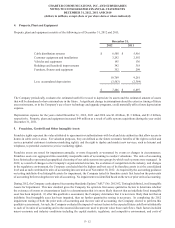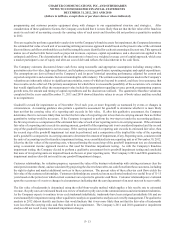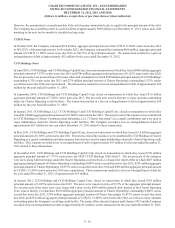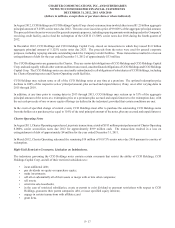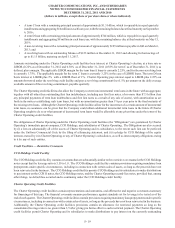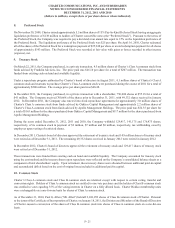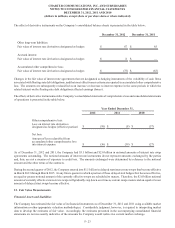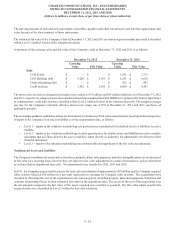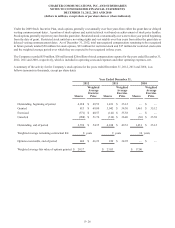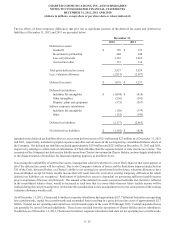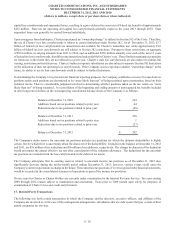Charter 2012 Annual Report Download - page 97
Download and view the complete annual report
Please find page 97 of the 2012 Charter annual report below. You can navigate through the pages in the report by either clicking on the pages listed below, or by using the keyword search tool below to find specific information within the annual report.
CHARTER COMMUNICATIONS, INC. AND SUBSIDIARIES
NOTES TO CONSOLIDATED FINANCIAL STATEMENTS
DECEMBER 31, 2012, 2011 AND 2010
(dollars in millions, except share or per share data or where indicated)
F- 22
Charter has outstanding 5.9 million warrants to purchase shares of Charter Class A common stock with an exercise price of $46.86
per share and 1.0 million warrants to purchase shares of Charter Class A common stock with an exercise price $51.28 per share,
both of which expire on November 30, 2014. Charter also has outstanding 4.7 million warrants to purchase shares of Charter
Class A common stock with an exercise price of $19.80 per share that expire on November 30, 2016 owned by Mr. Allen. The
warrants were valued at approximately $90 million on November 30, 2009, using the Black-Scholes option-pricing model and
are included in the accompanying balance sheets in total shareholders’ equity.
The following table summarizes our shares outstanding for the three years ended December 31, 2012:
Class A
Common
Stock
Class B
Common
Stock
BALANCE, December 31, 2009 112,576,872 2,241,299
CII exchange of Charter Holdco interest (see Note 16) 212,923 —
Restricted stock cancellations, net of issuances (311,650) —
Stock issuances from exercise of warrants 21 —
Stock issuances pursuant to employment agreements 16,000 —
Purchase of treasury stock (see Note 9) (176,475) —
BALANCE, December 31, 2010 112,317,691 2,241,299
Conversion of Class B common stock into Class A 2,241,299 (2,241,299)
Restricted stock issuances, net of cancellations 472,099 —
Option exercises 140,893 —
Stock issuances pursuant to employment agreements 7,000 —
Purchase of treasury stock (see Note 9) (14,608,564) —
BALANCE, December 31, 2011 100,570,418 —
Option exercises 370,715 —
Restricted stock issuances, net of cancellations 182,537 —
Stock issuances from exercise of warrants 179,850 —
Restricted stock unit vesting 51,476 —
Purchase of treasury stock (see Note 9) (178,749) —
BALANCE, December 31, 2012 101,176,247 —
11. Accounting for Derivative Instruments and Hedging Activities
The Company uses interest rate swap agreements to manage its interest costs and reduce the Company’s exposure to increases in
floating interest rates. The Company manages its exposure to fluctuations in interest rates by maintaining a mix of fixed and
variable rate debt. Using interest rate swap agreements, the Company agrees to exchange, at specified intervals through 2017, the
difference between fixed and variable interest amounts calculated by reference to agreed-upon notional principal amounts.
The Company does not hold or issue derivative instruments for speculative trading purposes. The Company has certain interest
rate derivative instruments that have been designated as cash flow hedging instruments. Such instruments effectively convert
variable interest payments on certain debt instruments into fixed payments. For qualifying hedges, realized derivative gains and
losses offset related results on hedged items in the consolidated statements of operations. The Company formally documents,
designates and assesses the effectiveness of transactions that receive hedge accounting.


